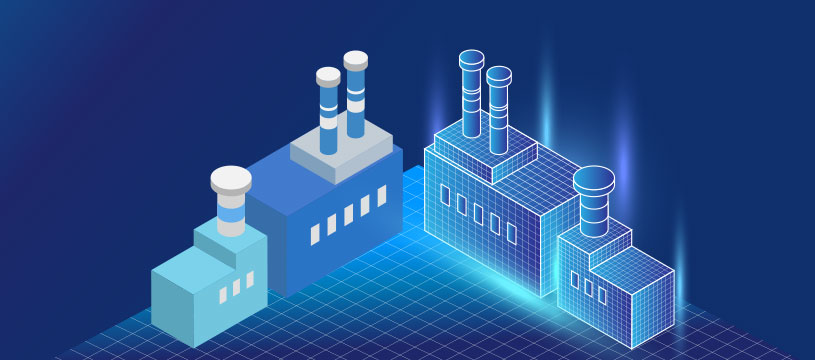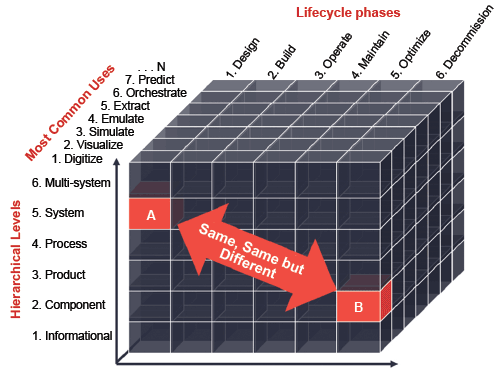- By Juan-Pablo Zeballos Raczy
- Digital Twin
Summary
Digital models, digital shadows, and digital twins help transform and optimize industrial and business operations.

Before we get to the applications, let’s look at some definitions. The International Organization for Standardization (ISO) has developed a digital twin framework for manufacturing where the concept of digital twins is defined as: “A fit-for-purpose digital representation of an observable manufacturing element with a means to enable convergence between the element and its digital representation at an appropriate rate of synchronisation.”
This means that a digital twin is a virtual replica of a physical component, product, system, or process within a manufacturing setting. Its function is to reflect the state or performance of the physical object in real time—not to enable further capabilities, such us simulation, orchestration, or prediction—and ultimately support operational decision making.
The digital twin concept comprises three main elements: the physical product, the digital product, and data connecting the two. Depending on the level of data integration, digital twins can be categorized into three subcategories (figure 1):
- A digital model is a digital representation of a physical object without any automated data exchange between the physical object and the digital object. This means that a change in the physical object is not reflected automatically into the digital object and vice versa.
- A digital shadow is a digital representation where an automated one-way data exchange exists, which means that a change in the physical object is reflected automatically into the digital object, but not vice versa.
- A digital twin is a digital representation where data is fully integrated and flows automatically in both directions between the physical object and the digital object.

Because digital twins are designed to model complex assets or processes that interact with several components, environments, and unpredictable variables, manufacturers need to have a range of capabilities already in place to deploy them. These include computer-aided design modeling, connectivity, cloud computing, Industrial Internet of Things (IIoT), a variety of different software platforms, augmented reality (AR) and virtual reality (VR) hardware, artificial intelligence (AI) and machine learning (ML), and systems integration.
The challenges associated with digital twin development include data growth, cybersecurity, the extent of digital skills required, and change management. Despite the challenges, the digital twin is quickly becoming a relevant technology, and manufacturers should start thinking of piloting new projects.
Why digital twins are important now
During the past decade, digital twin capabilities have been evolving rapidly because of a series of technology enablers and drivers:
- Access to larger volumes of data and machine learning make it possible to create more detailed simulations with enhanced depth and usefulness of insights.
- Better asset monitoring technologies and new sources of data enable continuous real-time simulations.
- Enhanced industry standards for communications between sensors and operational hardware and diverse platforms have improved interoperability.
- Better data visualization technology (e.g., 3D, VR, AR, AI-enabled visualizations) can handle greater volumes of data.
- Instrumentation is becoming smaller, more accurate, more powerful, and cheaper.
- Compute power, network, and storage are becoming more powerful and cheaper.
It is worth mentioning that a few other key enabling technologies are becoming cost effective and are being adopted: AI, ML, IoT, high-performance computing, cloud computing, and more are what allow digital twins to be so powerful today as opposed to five years ago. Technology companies are significantly investing in improving these digital enablers. Some of these investments are supporting the development of specific digital twin use cases.
Technology vendors have been shifting their attention to developing strong digital twin offerings. In the past few years, several—including IBM, Oracle, SAP, Microsoft, Amazon AWS, Rockwell, Siemens, and GE—have developed and launched digital twin offerings. Some also have made acquisitions to strengthen and build advanced digital twin capabilities.
Digital twin trends and smart factories
Digital twins are being used alongside other Industry 4.0 and smart factory applications in a variety of industries. A growing number of organizations in asset-heavy industries, such as aerospace, automotive, industrial products, and oil and gas, are implementing digital twins to transform their operations. Nonheavy and nonmanufacturing industries in sectors such as consumer goods, retail operations, facility management, health care, and smart cities also are piloting and starting to adopt digital twins.
Other companies are increasing the scale of digital twin deployment, because it provides real business value: It helps companies transform and future proof their businesses to deal with uncertainties and stringent competition. According to Deloitte, digital twin technology can deliver specific business value in the following areas:
- improve quality of product and processes and help predict and detect quality defects quicker
- improve customer service by enabling a better understanding of equipment and determining warranty costs and claim issues more accurately
- reduce operating costs by improving product design, equipment performance, and by streamlining operations and reducing process variability
- create record retention of serialized parts and raw materials to support tracking and quality investigation
- reduce time to market and cost to produce a new product by reducing lead times of components and optimizing supply chain performance
- create new revenue growth opportunities by helping to identify new products and improving efficiency and cost to service.
To help understand where digital twins can be used within a smart factory, a framework created by IoT Analytics breaks down the cases and capabilities, using three dominant dimensions: the hierarchical level of a digital twin (six levels), the lifecycle phase in which the digital twin is applied (six levels), and the use or capability of the digital twin (seven levels). An additional fourth dimension can be added that specifies the data type used by the digital twin; this can be real-time, historical, or test data (figure 2). Therefore, according to this framework, there are at least 250 combinations or types of digital twins (6×6×7=252). 
One of the best examples of how to implement digital twins in manufacturing to support smart factory initiatives is Unilever. In 2019, Gartner named the consumer goods giant one of the industry’s best-performing supply chain leaders.
Unilever implemented digital twins of its manufacturing production line process to increase productivity, reduce waste, and make better operational decisions. Its digital twins are a type described by the IoT Analytics framework as process × operate × orchestrate.
According to a 2019 article in the Wall Street Journal, devices send real-time information on physical variables, such as temperatures and motor speeds, into the cloud. Advanced analytics process this data and simulate conditions to ultimately map out the best operational conditions to control and adjust the production process. This results in better quality and productivity. Unilever worked with Microsoft to implement digital twins of dozens of its 300 global plants, and each twin reportedly was implemented in three or four weeks.
Another interesting example is digital twins in the field of maintenance prediction. Using the digital twin, a company can develop predictive maintenance strategies based on the digital replica of a machine or group of machines.
With this technology, maintenance specialists can simulate future operations of the machine, create failure profiles, calculate the remaining useful life of the machine, and plan maintenance activities based on the simulation results. All of this happens without the machine being stopped. The digital twin collects machine data from the machine controller and external sensors; this data is fed into a simulation model that uses algorithms and data analysis technologies to predict the health status of the asset. According to the IoT Analytics framework, this type of digital twin is a product × maintain × predict digital twin.
Digital models, digital shadows, and digital twins are helping transform and optimize industrial and business operations today. Manufacturers that have not started down this path should begin thinking of pilot projects and what is needed to implement the technology.
Resources
ISO Digital twin framework for manufacturing
Digital twin in manufacturing: A categorical literature review and classification
Relationship between the physical world & digital
Expecting digital twins: Adoption of these versatile avatars is spreading across industries
Hype Cycle for Manufacturing Digital Transformation and Innovation
Industry 4.0 and the digital twin
Digital twins: Bridging the physical and digital
Digital twins: The art of the possible in product development and beyond
Digital Twin Market - Global Forecast to 2026
Survey Analysis: Digital Twin Expansion Plans Signal New Software Skills Investments Are Required
Digital Twin Use Cases in Manufacturing – Part 5/12
How the world’s 250 Digital Twins compare? Same, same but different
Unilever Uses Virtual Factories to Tune Up Its Supply Chain
Using digital twin for maintenance applications in manufacturing: State of the Art and Gap analysis
Reader Feedback
We want to hear from you! Please send us your comments and questions about this topic to InTechmagazine@isa.org.


